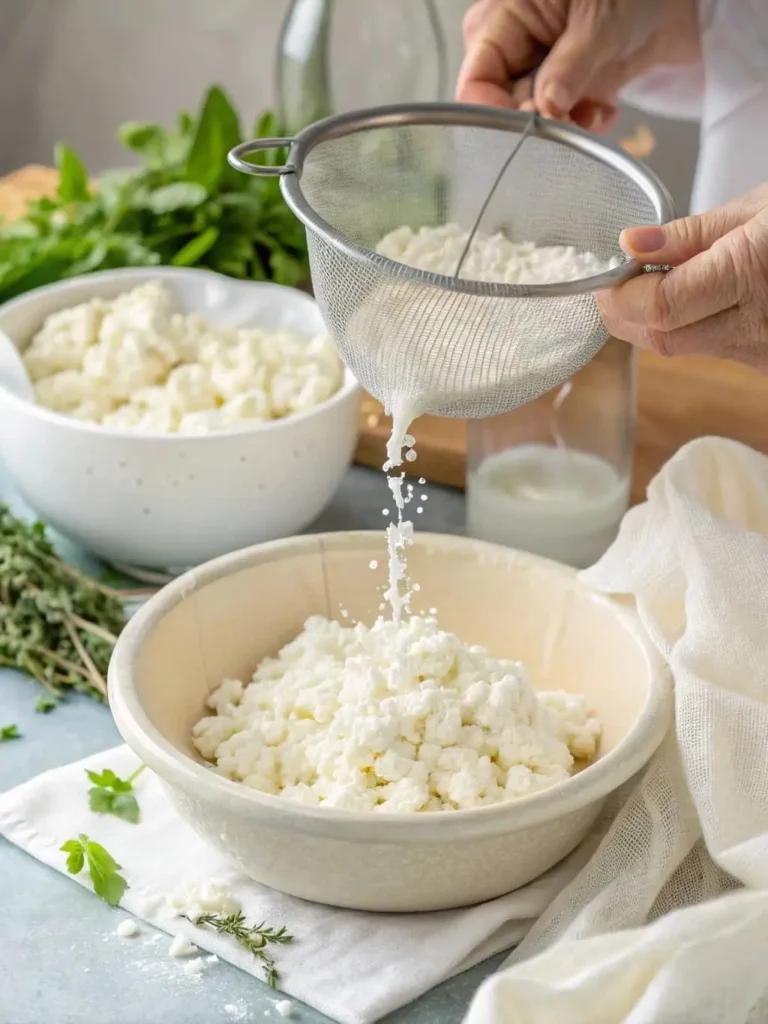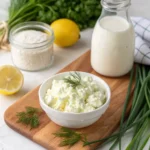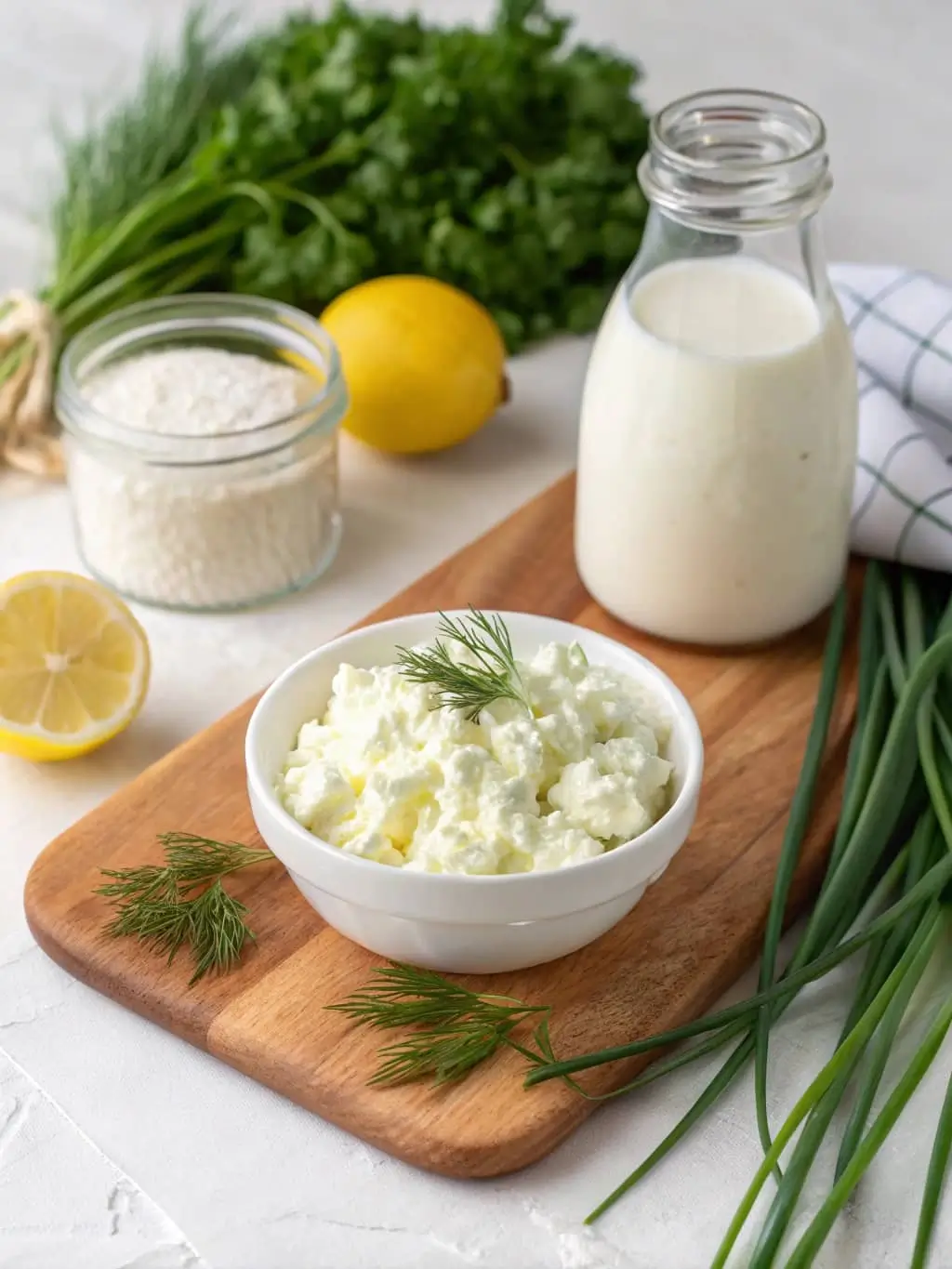Table of Contents
Did you know that the average store-bought cottage cheese contains up to 400mg of sodium per half-cup serving? That’s nearly 20% of your recommended daily intake in just one small portion! Cut back on salt without sacrificing taste. This low sodium cottage cheese recipe is fresh, creamy, and simple to make. Discover how now! By creating your own cottage cheese at home, you can reduce sodium content by up to 75% while enhancing flavor and nutritional value. Whether you’re managing hypertension, following a heart-healthy diet, or simply looking to reduce your salt intake, this homemade alternative puts you in control of what goes into your food.
Ingredients List
For this deliciously creamy low sodium cottage cheese, you’ll need:
- 1 gallon of whole milk (organic preferred for richer flavor)
- ¼ cup of white vinegar or fresh lemon juice (for a brighter, citrus undertone)
- 2 tablespoons of heavy cream (optional, for extra creaminess)
- ¼ teaspoon of sea salt (provides just 160mg of sodium for the entire batch)
- Fresh herbs like dill, chives, or parsley (optional for flavor enhancement)
Substitution options: Use 2% milk for a lighter version, apple cider vinegar for a subtle tanginess, or Greek yogurt instead of heavy cream for a protein boost.
Timing
- Preparation time: 10 minutes
- Processing time: 45 minutes
- Draining time: 30-60 minutes
- Total time: 1.5-2 hours (approximately 30% less time than other homemade cheese recipes)
The active cooking time is minimal—most of the process involves waiting as the curds form and drain, allowing you to multitask around the kitchen.
Step-by-Step Instructions
Step 1: Heat the Milk
Pour the gallon of milk into a large, heavy-bottomed pot. Heat it slowly over medium heat until it reaches 180°F (82°C). Use a food thermometer for accuracy—this precise temperature activates the proteins necessary for proper curd formation. Stir occasionally to prevent scorching on the bottom. If you notice a skin forming on top, gently skim it off.

Step 2: Add the Acid and Form Curds
Once your milk reaches 180°F, remove the pot from heat. Slowly pour in the vinegar or lemon juice while gently stirring. You’ll immediately notice the milk beginning to separate into curds (solid) and whey (liquid)—this chemical reaction is what transforms ordinary milk into cottage cheese! Let the mixture sit undisturbed for 15 minutes. The longer you wait, the firmer your curds will become.
Step 3: Drain and Rinse
Line a colander with cheesecloth or a clean kitchen towel and place it over a large bowl. Carefully pour the curds and whey into the colander. For a milder flavor and even lower sodium content, rinse the curds gently with cool water. The rinsing process removes residual acidity and creates that signature mild cottage cheese taste. Allow the curds to drain for 30 minutes to an hour, depending on your preferred moisture level.
Step 4: Finish and Flavor
Transfer the drained curds to a bowl and break them up to your desired consistency using a spoon or fork. Small, uniform curds work best for spreads, while larger curds create a more traditional cottage cheese texture. Fold in the optional heavy cream for richness, then add the minimal salt and any fresh herbs. Mix gently to avoid breaking the curds too much. Your homemade low sodium cottage cheese is now ready to enjoy!
Nutritional Information
A half-cup serving (4oz) of this homemade low sodium cottage cheese contains:
- Calories: 110
- Protein: 13g
- Fat: 5g
- Carbohydrates: 3g
- Sodium: 40mg (compared to 350-400mg in commercial brands)
- Calcium: 10% of daily value
- Vitamin D: 15% of daily value when using vitamin D-fortified milk
Research shows that reducing sodium intake by just 1,000mg per day can lower blood pressure by 5-6 mm Hg, making this recipe a heart-healthy choice.
Healthier Alternatives for the Recipe
- Ultra-low sodium version: Skip adding any salt and enhance flavor with lemon zest, herbs, and a touch of honey.
- Higher protein option: Add 2 tablespoons of unflavored whey protein powder to the finished cheese.
- Dairy-free adaptation: Though not technically cottage cheese, a similar texture and experience can be created using firm tofu crumbled with a splash of lemon juice and nutritional yeast.
- Mediterranean twist: Mix in 1 tablespoon of olive oil, chopped cucumbers, and fresh mint for a protein-rich spread.
Serving Suggestions
- Layer with fresh berries and a drizzle of honey for a protein-packed breakfast
- Spread on whole grain toast and top with sliced avocado and tomatoes
- Mix into scrambled eggs for added protein and creaminess
- Use as a protein-rich filling for twice-baked potatoes
- Blend into smoothies for a protein boost without added sodium
- Serve as a dip with crudités for a healthy snack option
Common Mistakes to Avoid
- Heating the milk too quickly: This can cause scorching and impart a burnt flavor. A study by the Journal of Dairy Science found that slow heating preserves more beneficial proteins.
- Using ultra-pasteurized milk: This type of milk forms weaker curds. Choose regular pasteurized milk for better results.
- Over-rinsing the curds: While rinsing reduces sodium and acidity, excessive rinsing can wash away flavor compounds. A quick 10-second rinse is typically sufficient.
- Adding salt while the curds are forming: This interferes with the curdling process. Always add salt after draining.
Storing Tips for the Recipe
Store your homemade cottage cheese in an airtight glass container in the refrigerator for up to 5-7 days. The flavor is most vibrant within the first 3 days. If the cheese seems to dry out, simply add a splash of milk and stir gently to refresh the texture.
For meal prep, you can make a larger batch and portion it into individual containers with different mix-ins for variety throughout the week. Unlike commercial versions with preservatives, watch for any changes in smell or appearance after day 5.
Conclusion
With just four simple steps, you’ve created a delicious, heart-healthy alternative to store-bought cottage cheese with dramatically less sodium. Not only is this homemade version better for your health, but it also delivers superior flavor and freshness that commercial products can’t match. The versatility of this recipe makes it a perfect addition to your weekly meal prep routine.
Take control of your sodium intake without sacrificing the foods you love. Try this low sodium cottage cheese recipe today, and experience the satisfaction of creating a nutritious, delicious staple in your own kitchen. We’d love to hear how you customized your batch or served it in creative ways!
FAQs
How does homemade cottage cheese compare nutritionally to store-bought?
Homemade cottage cheese typically contains 80-90% less sodium, no preservatives, and no added stabilizers or thickeners. The protein content is comparable, but the calcium may be slightly lower than fortified commercial versions.
Can I freeze this low sodium cottage cheese?
Freezing isn’t recommended as it significantly alters the texture. The curds tend to become rubbery and the moisture separates upon thawing.
Why didn’t my milk curdle properly?
This usually happens when using ultra-pasteurized milk or if the acid wasn’t added at the correct temperature. Try using regular pasteurized milk and ensure it reaches 180°F before adding the vinegar or lemon juice.
Is this recipe suitable for lactose-intolerant individuals?
The fermentation process reduces lactose content somewhat, but not enough for most lactose-intolerant individuals. Consider using lactose-free milk as your base ingredient.
How can I make a flavored version without adding sodium?
Try adding fresh herbs, citrus zest, cracked black pepper, or a touch of honey. Spices like cinnamon, nutmeg, or cardamom work wonderfully for sweet applications.
More Easy Recipes to Try:
- Best Low Carb Tortilla Chips Recipe in 4 Easy Steps
- Pitaya Bowl : 5 Easy Steps to a Bright, Healthy Breakfast
- Cottage cheese cookie dough: 6 Guilt-Free Bites You’ll Love

Low sodium cottage cheese: 4 Easy Steps to Make It at Home
- Total Time: 1.5 – 2 hours
- Yield: About 3–4 cups 1x
Description
Fresh, creamy cottage cheese with 75% less sodium than store-bought. Made with just 4 ingredients and no preservatives—heart-healthy and delicious!
Ingredients
- 1 gallon of whole milk (organic preferred for richer flavor)
- ¼ cup of white vinegar or fresh lemon juice (for a brighter, citrus undertone)
- 2 tablespoons of heavy cream (optional, for extra creaminess)
- ¼ teaspoon of sea salt (provides just 160mg of sodium for the entire batch)
- Fresh herbs like dill, chives, or parsley (optional for flavor enhancement)
Instructions
Step 1: Heat the Milk
Pour the gallon of milk into a large, heavy-bottomed pot. Heat it slowly over medium heat until it reaches 180°F (82°C). Use a food thermometer for accuracy—this precise temperature activates the proteins necessary for proper curd formation. Stir occasionally to prevent scorching on the bottom. If you notice a skin forming on top, gently skim it off.
Step 2: Add the Acid and Form Curds
Once your milk reaches 180°F, remove the pot from heat. Slowly pour in the vinegar or lemon juice while gently stirring. You’ll immediately notice the milk beginning to separate into curds (solid) and whey (liquid)—this chemical reaction is what transforms ordinary milk into cottage cheese! Let the mixture sit undisturbed for 15 minutes. The longer you wait, the firmer your curds will become.
Step 3: Drain and Rinse
Line a colander with cheesecloth or a clean kitchen towel and place it over a large bowl. Carefully pour the curds and whey into the colander. For a milder flavor and even lower sodium content, rinse the curds gently with cool water. The rinsing process removes residual acidity and creates that signature mild cottage cheese taste. Allow the curds to drain for 30 minutes to an hour, depending on your preferred moisture level.
Step 4: Finish and Flavor
Transfer the drained curds to a bowl and break them up to your desired consistency using a spoon or fork. Small, uniform curds work best for spreads, while larger curds create a more traditional cottage cheese texture. Fold in the optional heavy cream for richness, then add the minimal salt and any fresh herbs. Mix gently to avoid breaking the curds too much. Your homemade low sodium cottage cheese is now ready to enjoy!
- Prep Time: 10 minutes
- Cook Time: 45 minutes
- Category: Basics / Dairy
- Method: Boiling / Draining
- Cuisine: American
Nutrition
- Serving Size: About 3–4 cups

